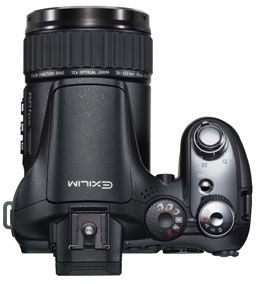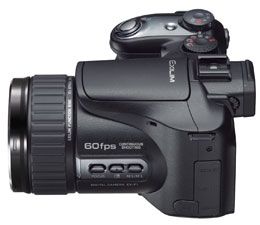Laptop Mag Verdict
This innovative super-zoom camera records full HD and slow-motion movies and can shoot a whopping 60 frames per second.
Pros
- +
Takes slow-motion video at three speeds
- +
Highly effective burst shooting
- +
Intuitive menu system
Cons
- -
Slow startup, processing speeds
- -
Can't adjust settings during high-speed shooting
- -
Doesn't come with photo editing/management software
Why you can trust Laptop Mag
Speed and Battery Life
Despite its ability to fire off 60 shots per second, the EX-F1 is slow in other ways: It takes about 3 seconds to boot up and also to ready itself between two individual shots. That's about three times as long as some speedy point-and-shoots--let alone most DSLRs. Luckily, the battery is long-lasting: Ours still had three bars after several days of shooting. That's good news for a camera whose most useful features--high-speed shooting and Pre-Record mode--require you to keep the camera on.

Click to enlargeWith the exception of the YouTube uploader, the EX-F1 does not come with any software. Casio seems to assume that someone interested in shelling out a grand for a high-end camera would already own photo-editing software, such as Adobe Photoshop Elements or Premiere Elements. However, many buyers upgrading from less complex cameras will have only the software that came with their last point-and-shoot.
The Verdict
The Casio EX-F1 is unlike any camera you've seen. It's impressive--often addictive--but it's not for everyone. Photography purists are better off with a DSLR, and people less prone to shooting fast-moving subjects can get away with buying a point-and-shoot for a third of the price. But DSLRs can't shoot video of any kind, let alone full HD and slow motion, and no point-and-shoot can match the EX-F1's rate of 60 shots per second. If you love photo and film equally, or have a penchant for challenging action photography, the $999 EX-F1 is worth the splurge.
Full HD Recording
In addition to slow-motion shooting, the EX-F1 records 1920 x 1080 HD video at a rate of 60 frames per second. Our footage was fluid with excellent sound. We like how the separate movie and still shutter buttons let you snap a photo while recording video. When you're done, you can plug the camera into your HDTV using the mini-HDMI port. In addition to stereo mics, the EX-F1 features a jack for an external mic. We wish you could use face detection while recording video, as you can on Sony's newest HD Handycams.
If HD isn't necessary, you can also record at VGA and upload to YouTube using the included YouTube uploader (CD installation required). As with theCasio EZ-Z77, we found the interface ugly but easy to use.
Strong Image Quality

Click to enlarge
It's easy to forget that the EX-F1 is, above all, a camera. Our 6-megapixel shots showed crisp details and accurate color, even in low light. Some of our shots taken in a dim room looked as if they were taken during the day, not at night, but the flash managed not to overwhelm our subjects' faces. Auto image stabilization produces clear shots, although you can set the camera to compensate for just moving hands or moving subjects. The face-detection feature recognized our subject immediately, but we didn't notice a huge difference in shots after we disabled it.

Click to enlarge
While powerful, the 12X zoom moves somewhat abruptly; for more nuanced control, we recommend using the lens ring to adjust zoom. Unfortunately, you can't use the lens ring to adjust the zoom during filming, so you're stuck with the jerky toggle zoom in that case.
Addicted to Slow-Mo
High-speed shooting is the best digital imaging feature you didn't know you needed. With the choice of shooting at 300, 600, or 1,200 frames per second, you can make movies that are slow, slower, and, well, slowest. Why does anyone need this? For starters, the results are compelling and often hilarious. Even the most mundane clips (in our case, a bellowing woman) become uproariously melodramatic when slowed to a crawl. Second, slow-motion footage makes movies look artistic. We used it to shoot water trickling off the underside of a stone fountain, but you can also use it to shoot wildlife, athletes, or anything else that's unlikely to slow down while you wrangle the perfect shot.
Slow-motion shooting isn't without its shortcomings. It requires ample light--more than you might expect--particularly as you ramp up the frame rate. Our attempts to shoot in a dim room produced barely discernible images, as did our attempts in an office with fluorescent lighting. Our videos shot in broad daylight were viewable, but they still looked overcast at 1,200 fps. In general, 1,200 fps isn't necessary: 300 is slow enough to look interesting; footage shot at 600 fps looks more dramatic but still sufficiently bright. Here's another pointer: Even a few seconds' worth of footage will translate to minutes in high-speed shooting; 10 seconds shot at 300 fps yielded 1:47 of footage. Unless your attention span is made of steel, keep these clips brief.
Increasing the frame rate also means decreasing the resolution. At 300 fps, the resolution is 512 x 384, but by the time you get to 1,200 fps, the resolution drops to 336 x 96--a narrow band in the middle of your screen. These small clips are inconvenient to watch, look ugly on an otherwise blank monitor, and, most importantly, can't fit nearly as much action inside. You can back up, but unfortunately you can't adjust the zoom, focus, or exposure while shooting in this mode. Moreover, slow-motion videos have no sound.
300 fps
[flv:http://blog.laptopmag.com/flvs/Casio-water-300fps.flv 480 360]
600 fps
[flv:http://blog.laptopmag.com/flvs/Casio-water-600fps.flv 480 360]
1200 fps
[flv:http://blog.laptopmag.com/flvs/Casio-water-1200fps.flv 480 360]
Pick the Perfect Shot
High-speed video clips shot with the EX-F1 can look amazing, but you can't take still images while shooting in slow-motion. For situations like these, Casio offers impressive high-burst shooting. Whereas many point-and-shoots take 3 shots per second (maybe a dozen if you slash the resolution), the EX-F1 takes a remarkable 60 shots per second, all at full 6-megapixel resolution. Just set the camera to continuous shooting and select how many shots you want, using a sliding scale on the LCD. You can also parcel out the 60 shots however you like (e.g. 12 shots per second for five seconds), and use the lens ring to adjust the burst rate while you're shooting. Such rapid shooting is possible thanks to a built-in LED video light. When shooting 20 frames per second or less, the flash becomes critical: It fires 7 times a second for up to 3 seconds.
The resulting collection of images looks like a flip animation as you scroll through them. We love that in playback mode the camera displays these shots as a single folder, so scrolling past them takes a single click, not 60.
In short, high-speed shooting works like a charm. We used it to photograph toddlers and animals, but our favorite strip included a crisp still of a pigeon taking flight, its wings raised high, its feet en pointe. Unfortunately, after we took a batch of 60 shots the camera took 16 seconds to process them. If you're in a high-octane situation where burst shooting comes in handy, it can be frustrating to wait for the camera to process images while you watch the action go by.

Click to enlarge

Click to enlarge

Click to enlarge

Click to enlarge

Click to enlarge

Click to enlarge

Click to enlarge

Click to enlarge

Click to enlarge
Other Action Photography Options
In addition to burst shooting, you can set the LCD to show action in slow motion so that you can get the right shot without ending up with 60 candidates. The EX-F1 also boasts an innovative feature called Pre-Record mode, which is ideal for situations where action is imminent (Mariano Rivera is about to throw a ninth-inning pitch, for example). Half-press the shutter and the camera will cache up to 60 images--before you even press the shutter button. Just make sure it's a day game, though: As with high-speed shooting, bright light is necessary, since the flash doesn't go off in pre-record mode.
First things first: Casio's Exilim EX-F1 is not a digital SLR. Although it looks like one, it's for people who love filming as much as capturing photos. In addition to snapping 6-megapixel still photos, the EX-F1 can fire off up to 60 shots per second, record movies in full HD, and make slow-motion videos using high-speed shooting up to 1,200 frames per second. The EX-F1 was built for people who love action photography or want a camera that can do double duty as a camcorder, and based on our tests, it's certainly a breakthrough.
Looks Like a DSLR
Three things make the EX-F1 look like a DSLR: its electronic view finder, its chunky shape--complete with a rubbery ergonomic hand grip--and the long 12X lens. Compared with a DSLR, though, it's much lighter. At 1.5 pounds, it weighs less than many DSLRs once you factor in their removable lenses. The EX-F1's nonremovable lens has a rotating ring that you can program to control the focus, burst rate, and zoom factor.
For not-so-advanced shooters, the 2.8-inch LCD has Live View, just like any other digital point-and-shoot, and you can enable it by pressing the dedicated EVF/LCD button on the back. We had no problem viewing images on the LCD outside on a sunny day.
Unlike simpler point-and-shoots, whose few buttons are self-explanatory, the EX-F1 requires you to read the instruction manual. On the top are two dials: one for camera modes and another for continuous shooting options. Also on top are the Power button and the shutter, with a rotating toggle for adjusting the zoom.

Click to enlargeOn the left side are focus, backlight correction, and AE-L/AF-L buttons (the latter locks exposure and focus). On the back is another button for recording video; it has a rotating toggle for selecting high-speed shooting, high-definition shooting (1920 x 1080), or standard-def shooting (640 x 480). The EX-F1 also has a four-way touchpad with a scroll wheel surrounding it, as well as dedicated Menu, Display, Playback, and Record buttons.
User-Friendly Interface
Fortunately, the on-screen menus are less complicated. The settings you're most likely to adjust--ISO and white balance, for example--have corresponding icons lining the right side of the LCD. Use the Up and Down arrow keys to highlight them, and the right and left to make adjustments. We like that when you press the Menu button, highlighted settings appear red, and all others gray; it makes navigating all the manual options easy.
Casio Exilim EX-F1 Specs
| Camera Type | Ultra-zoom |
| Company Website | www.casiousa.com |
| Digital Camera LCD Size | 2.8 inches (230,160 pixels) |
| Internal Memory | 32 |
| Megapixel | 6 |
| Size | 5.1 x 5.0 x 3.1 inches |
| Still Image Format | RAW, JPEG |
| Weight | 1.5 pounds/24 oz. |
